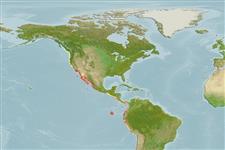Teleostei (teleosts) >
Eupercaria/misc (Various families in series Eupercaria) >
Latilidae (Deepwater tilefishes)
Etymology: Caulolatilus: Greek, kaulos = stem, stalk + Latin, latus = wide (Ref. 45335); princeps: princeps meaning leader (Ref. 6885).
More on author: Jenyns.
Environment: milieu / climate zone / depth range / distribution range
Ecology
Marine; reef-associated; depth range 10 - 91 m (Ref. 5227), usually 24 - 55 m (Ref. 5227). Subtropical; 51°N - 18°S, 129°W - 70°W
Eastern Pacific: Vancouver Island in British Columbia, Canada to Peru, including the Galapagos Islands; rare north of central California, USA.
Size / Weight / Age
Maturity: Lm ? range ? - ? cm
Max length : 102 cm TL male/unsexed; (Ref. 2850); max. published weight: 5.8 kg (Ref. 40637)
Inhabits rocky bottoms (Ref. 9119). Also found on soft sand and mud bottoms. Solitary species. Digs into the substrate for food (Ref. 5227).
Life cycle and mating behavior
Maturity | Reproduction | Spawning | Eggs | Fecundity | Larvae
Dooley, J.K., 1978. Systematics and biology of the tilefishes (Perciformes: Branchiostegidae and Malacanthidae) with descriptions of two new species. NOAA Tech. Rep. NMFS Circ. No. 411:1-78. (Ref. 8991)
IUCN Red List Status (Ref. 130435: Version 2024-1)
Threat to humans
Harmless
Human uses
Fisheries: commercial; gamefish: yes
Tools
Special reports
Download XML
Internet sources
Estimates based on models
Preferred temperature (Ref.
123201): 15.8 - 25.6, mean 19 °C (based on 32 cells).
Phylogenetic diversity index (Ref.
82804): PD
50 = 0.5005 [Uniqueness, from 0.5 = low to 2.0 = high].
Bayesian length-weight: a=0.00708 (0.00294 - 0.01707), b=3.07 (2.86 - 3.28), in cm total length, based on LWR estimates for this (Sub)family-body shape (Ref.
93245).
Trophic level (Ref.
69278): 3.6 ±0.45 se; based on food items.
Resilience (Ref.
120179): Low, minimum population doubling time 4.5 - 14 years (Assuming tm>4).
Fishing Vulnerability (Ref.
59153): High vulnerability (61 of 100).
Climate Vulnerability (Ref.
125649): Moderate to high vulnerability (48 of 100).
Nutrients (Ref.
124155): Calcium = 17.1 [7.9, 32.3] mg/100g; Iron = 0.401 [0.226, 0.719] mg/100g; Protein = 18 [16, 21] %; Omega3 = 0.121 [0.066, 0.214] g/100g; Selenium = 23.3 [11.3, 47.1] μg/100g; VitaminA = 34.2 [11.0, 109.7] μg/100g; Zinc = 0.635 [0.417, 0.938] mg/100g (wet weight); based on
nutrient studies.
